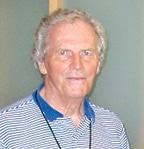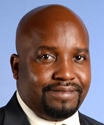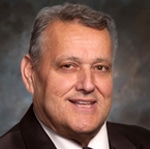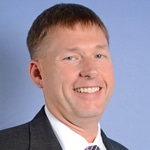
To be described as a “classic” means that one is considered to be of the highest quality with lasting value; an authoritative standard; fashionable, with simplicity and restraint in style; one of a kind. Like the classic ‘57 Chevy or the fashionable Elvis Presley, SMART General Chairperson William A. Beebe is a classic in his own right.
Amtrak GO 663 General Chairperson Beebe is a classic railroad union man who has withstood the test of time. On Jan. 1, he will have completed 60 years of service as a union representative to the Brotherhood of Railroad Trainmen, the former UTU, and now the SMART Transportation Division. More amazingly, Beebe will turn 86 years young in January and shows no signs of slowing down. Throughout those 60 years, the membership has been his top priority.
GO 663 Vice General Chairperson Gary J. Hopson offered highlights of Beebe’s union career. Beebe has been a delegate to every national convention since the creation of the UTU. He has witnessed, firsthand, the evolution of this union and has often been described as the union’s resident historian. Hopson said Beebe was an active participant in the formation of the UTU.
According to Local 227 (Hartford, Conn.) Chairperson Francis L. Ariola, Beebe proudly served in the U.S. Army, beginning in 1946. He later attended college at the University of South Florida and Southern Connecticut State University, where he earned both a bachelor’s degree and teaching certificate.
He hired out in 1951 with the New Haven Railroad (New York, New Haven and Hartford Railroad) in the mail and baggage department, and on May 29, 1953, he transferred into operations as a brakeman, joining the BRT on Aug. 1, 1953. On Jan. 1, 1954, Beebe assumed the office of secretary of the local committee of adjustment for BRT Lodge 937 (now Local 1361). He was elected vice local chairperson in 1957 and became local chairperson in 1962. While serving simultaneously as local chairperson and Connecticut state legislative director from 1964 to 1976, he was elected general chairperson on the former New Haven and Hartford Railroad in 1976.
In 1983, Beebe led UTU-represented Metro North Railroad employees through a six-week strike that resulted in a ground-breaking agreement that has become the benchmark for commuter rail contracts. SMART TD members still benefit from that agreement today, Hopson said. “Now, our committee handles our own contract negotiations with Amtrak with minimal national involvement by the International. Beebe’s 1983 agreement opened the door to this.”
In addition to serving as general chairperson, Local 1361 delegate and trustee, Beebe is again the Connecticut state legislative director. He maintains a rigorous caseload and there are no indications that retirement will ever even be a consideration of his, Ariola said.
So how does Beebe keep it all going? According to Ariola, Beebe makes a concerted effort to stay healthy through physical fitness, diet and rest. “He is very health-conscious and works out every day, and has even been known to beat racquetball opponents 30 years his junior.”
Hopson provides more evidence, explaining that, “Beebe was a renowned handball player at the New Haven YMCA, and played masterful tennis even into his seventies.” According to Ariola, Beebe was a successful minor league pitcher in the Drummond Baseball League during the early 1950s. He is also a family man and ensures that he is involved in his two granddaughters’ lives by frequently visiting his daughter Susan’s family in Oregon. “He just loves his grandkids and they love their grandpa,” Ariola said.
“As the union’s ‘resident historian,’ Bill has accumulated a lot of stuff over the years. He keeps the most current union contract with him at all times, in the very likely event that someone asks his opinion about some vague, but pertinent, contractual provision. Members are always asking for his thoughts on various provisions because they trust him as highly competent, knowledgeable and wise. The funny thing is that, he really doesn’t need it since he practically has it memorized.”
“As a union representative and as a man, Bill is fearless. The carriers know that he is a fighter and that he is never intimidated.”
As SMART embarks on another year, members can rest assured that Bill Beebe will continue to take care of business by representing them with the highest quality. Bill Beebe truly is a one-of-a-kind classic.
Author: amyr

By Alvy Hughes,
Alternate Vice President –
Although winter hasn’t arrived yet, many states have already seen winter conditions and record snowfall. It’s that time of the year that U.S. roads and highways can be hazardous for transportation.
According to the Federal Highway Administration (FHWA), more than 70 percent of the nation’s roads are located in snowy regions that receive more than five inches of average snowfall annually. Nearly 70 percent of the U.S. population lives in these snowy regions.
These conditions can be especially difficult for bus operators, as many people depend on us to get them to their destinations safely and on time.
We need to be extra cautious and prepared this season. Here are a few preventive measures you should practice to keep you and your passengers safe.
- Facility lots and walk areas may be in horrible condition due to weather. Watch for slick spots – especially ice – when approaching your bus. Always take the safest path.
- Make sure to do proper pre-trips. Checking tires, defroster, wiper blades, mirrors, lights and heating system are especially important in winter. If you discover any issues during your pre-trip, please write it up and report it to the proper company personnel. If your issues aren’t addressed, please contact your local union legislative representative.
- Many companies have a “no idling” policy to save on fuel, but it’s very important that you take some time to warm-up your vehicle.
- Be aware of the conditions around you at all times and remember that the posted speed limits are for normal road conditions.
- Enhanced driving skills, alertness and reaction time are needed in wintry conditions. (Bridges freeze first, and many exit ramps can be challenging due to the fact they may receive less attention than main roads.)
- Watch out for pedestrians.
- Always buckle your seat belt.
Our main goal is to be safe. All operators should have buses that are equipped with the necessities to handle the winter weather. Make sure that you put yourself and your passengers in the safest position at all times.
A SMART Transportation Division officer and a general chairperson have been elevated to new Transportation Division positions following the retirement of Alternate Vice President R.W. “Red” Dare Nov. 30.
The Transportation Division Board of Directors Dec. 19 elevated Executive Board Alternate John D. Whitaker III to fill the vacancy created by Dare’s retirement. At the same time, the board elected Union Pacific GO 927 Vice General Chairperson Jeremy Don Brooks to fill the executive board vacancy.
Whitaker began his railroading career in 1997 with CSX Transportation as a conductor and was promoted to engineer in 2002. Around that same time, Whitaker began his union career when he was elected local chairperson for engineers of Local 1106 at Rocky Mount, N.C.
Four years later, Whitaker ran for and was elected to the position of vice general chairperson of CSX General Committee of Adjustment GO 851. In 2011, he was elected general chairperson, a position that he still holds. In October 2013, Whitaker was appointed alternate to the executive board and then elected to that position by delegates at the 2014 Transportation Division convention. He currently resides with his wife and three sons in Jacksonville, Fla.
Brooks has been employed by Union Pacific railroad since 2004 and was promoted to engineer in 2007. Since then, he’s been active in the affairs of Local 937 at Mart, Texas. Brooks began his union career by serving as alternate delegate for his local. He rose through the ranks quickly, serving as local chairperson, vice general chairperson for GO 927 and then first vice chairperson for the committee. He currently holds both offices within the committee, as well as the position of local delegate. He currently resides in Burleson, Texas.
A member of Local 1525, Carbondale, Ill., Dare has served his union as local president, local chairperson, general secretary, vice general chairperson and general chairperson. He was elected alternate vice president-South by delegates at the UTU International convention in 2007. Dare was re-elected to the position in 2011 and at the first SMART Transportation Division convention in 2014.
Dare and his wife have three children and seven grandchildren. The family resides in Benton, Ill.
A man on Wednesday admitted in court to stealing two locomotives in Campbell County in October and crashing them into another train, according to information from the U.S. District Court of Wyoming.
Derek Skyler Brux entered into a plea deal with prosecutors during a hearing at the federal court building in Casper. John Powell, spokesman for the U.S. Attorney’s Office, said he could not release the terms of Brux’s plea deal.
Read the complete story at the Casper Star Tribune.
Fewer and fewer Americans belong to a union. Membership is down to a historic low of 11.2 percent of the work force, and only 6.7 percent of workers in the private sector.
And if the nation’s confidence in the institution is any measure, not many people are mourning its diminishment. According to a Gallup poll, organized labor inspires less confidence than banks.
Read the complete story at The New York Times.
The Associated Press article on railroads’ collective push to reduce freight train crews from two persons to one is informative yet fails to address the very real danger of equipment, mechanical or infrastructure failure.
As a matter of record I am a 40-year railroad conductor and chaired my union’s state safety board for 16 years.
Read the complete letter at Herald-Review.com.
The preceding “letter to the editor” written by retired member Lloyd R. Holman was published by the Herald Review on Jan. 22, 2015. Holman is a member of the UTU Alumni Association and is the former local secretary & treasurer and legislative representative of SMART Transportation Division Local 453 at Clinton, Ill. He also served as chairperson of the union’s Illinois State Legislative Board.
BNSF Railway Company (BNSF) Jan. 15 announced more details about the major capital projects it plans to complete in 2015 to maintain and grow its rail network.
In BNSF’s North Region, the company will invest approximately $1.5 billion across eight states for engineering maintenance and line expansion projects, of which approximately $700 million* is planned for projects to expand the rail lines and Positive Train Control (PTC) in that region. BNSF’s North Region has experienced the most rapid growth in recent years. It is the corridor used to move agriculture and coal to export facilities in the Pacific Northwest, petroleum products produced in the region that are destined for refinery facilities, and for consumer products shipped to and from marine ports in the Pacific Northwest. The North Region is also a destination point for materials that support the production of crude oil in the Bakken shale formation.
In BNSF’s South Region, the railroad plans to spend approximately $800 million in nine states for engineering maintenance and line expansion projects, of which $175 million is planned for line expansion initiatives and continued implementation of PTC. The South Region includes BNSF’s high-speed transcontinental route with more than 2,000 miles of double track that allows customers to move freight from West Coast marine ports to interchange facilities in Chicago as well as major rail terminals in Kansas City, Fort Worth, Denver and St. Louis.
In the Central Region, primarily used for the movement of coal, BNSF will invest approximately $650 million across six states for engineering maintenance and line expansion projects, of which almost $260 million is planned for line expansion projects and continued implementation of PTC.
“Building on the 2014 capacity increases, we will continue investing in our railroad to make us ever more capable of getting agriculture, energy supplies and a wide range of consumer and industrial products where they want to go,” said Carl Ice, BNSF president and chief executive officer. “At BNSF, we believe strongly in working with our customers to help them supply the world with food, energy and products that grow and build our economy. These unprecedented capital investments demonstrate to our customers how deeply committed we are to building a prosperous future for all of us.”
Highlights of BNSF’s planned capital investments in the company’s three operating regions are as follows:
North Region
BNSF plans to invest approximately $700 million in the North Region to expand rail capacity and continue the implementation of PTC technology. The North Region includes: Illinois, Minnesota, Montana, North Dakota, Oregon, South Dakota, Washington and Wisconsin.
Expansion projects include:
Continue to install double track on the Glasgow subdivision between Minot, N.D., and Snowden, Mont., located in the far western part of the state.
Extend the siding on the Dickinson subdivision located between Mandan, N.D., and Glendive, Mont., and expand the terminal at the Dickinson yard to accommodate expected growth in single car volumes.
Convert the entire Devils Lake subdivision, located between Minot, N.D., and Grand Forks, N.D., to centralized train control, which will improve capacity for freight operation while improving on-time performance of passenger trains.
Complete implementation of centralized train control on the Hillsboro subdivision, located in eastern North Dakota. Upgrade connection track between the Hillsboro subdivision and the Devils Lake subdivision to permit faster train speeds.
South Region
BNSF plans to invest approximately $175 million to expand rail capacity in the South Region and continue the implementation of PTC technology. The South Region includes: Arizona, Arkansas, California, Kansas, Louisiana, Mississippi, New Mexico, Oklahoma and Texas.
Expansion projects include:
Connect two sidings on the Mojave subdivision, which runs from Bakersfield, Calif., to Mojave, Calif., to create a short double track segment that will increase capacity.
Construct double track on the Panhandle subdivision located between Wellington and Avard, Okla., to improve Southern Transcon capacity.
Construct double track on the Clovis subdivision located between Belen and Clovis, N.M., to improve Southern Transcon capacity.
Central Region
BNSF plans to invest approximately $260 million to expand rail capacity and continue the implementation of PTC technology. The Central Region includes: Alabama, Colorado, Iowa, Missouri, Nebraska and Wyoming.
Expansion projects include:
Construct two new sidings on the northern and southern ends of the Hannibal subdivision located in western Illinois.
Construct two double track segments on the Ravenna subdivision, located in Nebraska, which will greatly improve capacity on this heavily-trafficked coal route.
Extend sidings at six locations on the Brush subdivision, located east of Denver, to improve the velocity of southern coal flows.
These planned capital investments are part of BNSF’s 2015 capital plan of $6 billion, which was announced in November and is the company’s largest planned capital expenditure in its history. The investments include $2.9 billion to replace and maintain core network and related assets, nearly $1.5 billion on expansion and efficiency projects, $200 million for continued implementation of PTC and about $1.4 billion for locomotives, freight cars and other equipment acquisitions.
For more details about the planned projects for 2015, please see the map located on bnsf.com.

Attendance is limited to 25 registrants. If demand for the workshop is high, another workshop will be scheduled shortly after.
Those interested in attending the workshop should contact the office of the SMART Transportation Division Updating/Auditing Department. Call (216) 228-9400, or email Karen Cashin at kcashin@smart-union.org.
While all treasurers will likely benefit from this workshop, newly elected treasurers are strongly encouraged to attend.
The three-day session will include all training and materials at no cost to local treasurers. However, the local is responsible for all other costs associated with the treasurer’s attendance at the workshop. Lost time or salary, travel, hotel and meal expenses connected with attendance may be reimbursed if pre-approved at a local meeting as an allowable expense of the local.
The workshop will provide local treasurers with hands-on training on the responsibilities and reporting duties pertaining to their office, including direct receipts and Winstabs. It will also focus on completion of mandatory filings for LM reports and Form 990 and Department of Labor requirements.
The workshop will be held at the Transportation Division headquarters at 24950 Country Club Blvd., Ste. 340, in North Olmsted, Ohio. Corporate room rates of $78 per night, plus tax, are available at the Radisson Hotel Cleveland Airport, 25070 Country Club Blvd. in North Olmsted, which is conveniently located adjacent to the parking lot of the Transportation Division offices. The deadline for room reservations is Feb. 9.
Reservations can be made by calling Radisson Hotel Cleveland Airport directly at (440) 734-5060. Provide advise the hotel representative that you are with the “SMART Transportation Division” group when making reservations. Radisson Hotel Cleveland Airport provides a complimentary shuttle service to and from the airport and a complimentary breakfast.
Training sessions will be conducted by SMART Transportation Division Field Auditors Bobby Brantley and Mike Araujo. Space is limited and attendees will be accepted in order of registration. It is recommended that those attending make their hotel reservations at the time of registration.
If one-on-one assistance is need by a treasurer, arrangements should be made in advance of the workshop by contacting Brantley at (216) 502-7225 or bbrantley@smart-union.org, or Araujo at (210) 710-4213 or maraujo@smart-union.org.
Attendees should bring a notebook computer and USB flash drive.
A prominent local businessman has offered to buy the New Orleans Public Belt Railroad.
In a statement released Wednesday morning, Thomas B. Coleman, a New Orleans native and former CEO of International-Matex Tank Terminals, said he wants to buy the Public Belt to spur the local economy and ensure the railroad remains locally owned.
Read the complete story at The Times-Picayune.


